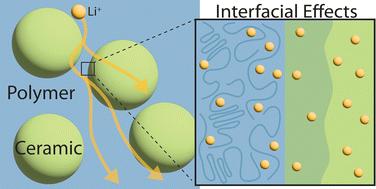当前位置:
X-MOL 学术
›
Chem. Soc. Rev.
›
论文详情
Our official English website, www.x-mol.net, welcomes your
feedback! (Note: you will need to create a separate account there.)
A critical review on Li-ion transport, chemistry and structure of ceramic–polymer composite electrolytes for solid state batteries
Chemical Society Reviews ( IF 40.4 ) Pub Date : 2024-11-18 , DOI: 10.1039/d4cs00214h Sara Catherine Sand, Jennifer L. M. Rupp, Bilge Yildiz
Chemical Society Reviews ( IF 40.4 ) Pub Date : 2024-11-18 , DOI: 10.1039/d4cs00214h Sara Catherine Sand, Jennifer L. M. Rupp, Bilge Yildiz

|
In the transition to safer, more energy-dense solid state batteries, polymer–ceramic composite electrolytes may offer a potential route to achieve simultaneously high Li-ion conductivity and enhanced mechanical stability. Despite numerous studies on the polymer–ceramic composite electrolytes, disagreements persist on whether the polymer or the ceramic is positively impacted in their constituent ionic conductivity for such composite electrolytes, and even whether the interface is a blocking layer or a highly conductive lithium ion path. This lack of understanding limits the design of effective composite solid electrolytes. By thorough and critical analysis of the data collected in the field over the last three decades, we present arguments for lithium conduction through the bulk of the polymer, ceramic, or their interface. From this analysis, we can conclude that the unexpectedly high conductivity reported for some ceramic–polymer composites cannot be accounted for by the ceramic phase alone. There is evidence to support the theory that the Li-ion conductivity in the polymer phase increases along this interface in contact with the ceramic. The potential mechanisms for this include increased free volume, decreased crystallinity, and modulated Lewis acid–base effects in the polymer, with the former two to be the more likely mechanisms. Future work in this field requires understanding these factors more quantitatively, and tuning of the ceramic surface chemistry and morphology in order to obtain targeted structural modifications in the polymer phase.
中文翻译:

固态电池用陶瓷-聚合物复合电解质的锂离子输运、化学和结构的批判性综述
在向更安全、能量密度更高的固态电池过渡的过程中,聚合物-陶瓷复合电解质可能提供一条潜在的途径,可以同时实现高锂离子电导率和增强的机械稳定性。尽管对聚合物-陶瓷复合电解质进行了大量研究,但对于此类复合电解质,聚合物或陶瓷的组成离子电导率是否受到积极影响,甚至界面是阻塞层还是高导电锂离子路径,仍然存在分歧。这种理解的缺乏限制了有效复合固体电解质的设计。通过对过去三十年在该领域收集的数据进行彻底和批判性的分析,我们提出了锂通过大部分聚合物、陶瓷或其界面传导的论点。从这一分析中,我们可以得出结论,一些陶瓷-聚合物复合材料报告的出乎意料的高电导率不能仅用陶瓷相来解释。有证据支持这一理论,即聚合物相中的锂离子电导率在与陶瓷接触时沿该界面增加。其潜在机制包括聚合物中自由体积增加、结晶度降低和调节路易斯酸碱效应,前两种机制更有可能。该领域的未来工作需要更定量地了解这些因素,并调整陶瓷表面化学和形态,以便在聚合物相中获得有针对性的结构修饰。
更新日期:2024-11-18
中文翻译:

固态电池用陶瓷-聚合物复合电解质的锂离子输运、化学和结构的批判性综述
在向更安全、能量密度更高的固态电池过渡的过程中,聚合物-陶瓷复合电解质可能提供一条潜在的途径,可以同时实现高锂离子电导率和增强的机械稳定性。尽管对聚合物-陶瓷复合电解质进行了大量研究,但对于此类复合电解质,聚合物或陶瓷的组成离子电导率是否受到积极影响,甚至界面是阻塞层还是高导电锂离子路径,仍然存在分歧。这种理解的缺乏限制了有效复合固体电解质的设计。通过对过去三十年在该领域收集的数据进行彻底和批判性的分析,我们提出了锂通过大部分聚合物、陶瓷或其界面传导的论点。从这一分析中,我们可以得出结论,一些陶瓷-聚合物复合材料报告的出乎意料的高电导率不能仅用陶瓷相来解释。有证据支持这一理论,即聚合物相中的锂离子电导率在与陶瓷接触时沿该界面增加。其潜在机制包括聚合物中自由体积增加、结晶度降低和调节路易斯酸碱效应,前两种机制更有可能。该领域的未来工作需要更定量地了解这些因素,并调整陶瓷表面化学和形态,以便在聚合物相中获得有针对性的结构修饰。

































 京公网安备 11010802027423号
京公网安备 11010802027423号